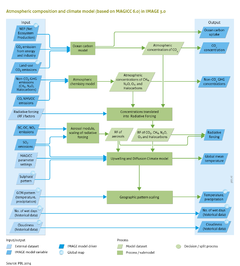Atmospheric composition and climate/Description: Difference between revisions
Jump to navigation
Jump to search
m (Text replace - "|Status=On hold" to "") |
No edit summary |
||
| Line 1: | Line 1: | ||
{{ComponentDescriptionTemplate | {{ComponentDescriptionTemplate | ||
|Reference=Forster et al., 2007; WMO/UNEP, 2013; | |||
|Description=Atmospheric gas concentrations | |||
The IMAGE climate model calculates atmospheric CO2 concentration based on CO2 emission data for energy, industry and land-use change ([[Emissions]]); terrestrial carbon balance ([[Natural vegetation and carbon cycle]]); and carbon uptake by the oceans (calculated in [[MAGICC model|MAGICC]] on the basis of the [[Bern Ocean Carbon model]]). | |||
Concentrations of other long-lived greenhouse gases (CH4, N2O, and halocarbons), and ozone (O3) precursors (CO, NMV OC) are calculated by MAGICC in a simple atmospheric chemistry module. Halocarbons and N2O concentrations mostly show a simple mass-concentration conversion and half-life behaviour. CH4 and ozone dynamics are more complex, with CH4 lifetime depending on the OH concentration level, and O3 and OH concentration levels depending on CH4, NOx, CO and NMVOC emissions ([[Meinshausen et al., 2011b]]). | |||
Atmospheric energy balance | |||
Change in atmospheric gas concentrations also changes the amount of radiation absorbed or transmitted by the atmosphere, and thus changes the earth’s energy balance and temperature. The energy balance change is expressed as radiative forcing per gas, measured in W/m2. In MAGICC, concentrations of long-lived greenhouse gases and O3 are translated into radiative forcing values using estimates from the IPCC AR4 ([[Forster et al., 2007]]). | |||
However, | However, other processes also lead to changes in the atmospheric energy balance, which are also modelled and assigned a radiative forcing value. Aerosol precursors, such as SO2, NOx, and organic carbon, have a direct cooling effect by reflecting more radiation back into space (direct aerosol effect). Although also an aerosol precursor, black carbon has a strong direct warming effect ([[WMO/UNEP, 2013]]), by acting as condensation nuclei for water vapour in the atmosphere. In very general terms, more clouds retain more energy in the earth’s atmosphere. | ||
Direct and the indirect aerosol effects are approximated in MAGICC by scaling the 2005 radiative forcing with the relative increase in future emissions above the emissions in 2005. As MAGICC assumes radiative forcing by albedo and mineral dust to stay constant over the scenario period ([[Meinshausen et al., 2011a]]), this is also assumed in IMAGE. | |||
Global mean temperature change | |||
The core of MAGICC 6.0, the upwelling–diffusion climate model, calculates change in global mean temperature as a result of these radiative forcings ([[Meinshausen et al., 2011a]]; [[Meinshausen et al., 2011b]]). It is a ‘four-box’ model, representing the earth by a northern and southern land component, and a northern and southern ocean component. | |||
The energy fluxes simulated by MAGICC include heat transport from the atmosphere through the mixing top layer of the ocean to lower water layers (60 layers), and heat transfer between land and ocean. Because of the slow heat transport to the ocean, the earth's temperature takes a long time to reach a new equilibrium after a change in radiative forcing. The model parameters that control heat transport and final change in global mean temperature calibrated to reproduce the results of 19 Global Circulation Models of AR4 ([[Meinshausen et al., 2011b]]). In addition, a medium parameterisation is available, which results in behaviour that represents the mean of these 19 model emulations. | |||
Downscaling | |||
The global mean temperature change from MAGICC, and maps of temperature and precipitation change are used in a pattern scaling, to derive spatially explicit temperature and precipitation changes at one-year time steps to be used in other IMAGE modules (on [[Natural vegetation and carbon cycle]], [[Crop and grass]], [[Hydrological cycle]], [[Nutrient balances]]). | |||
Grid-specific temperature and precipitation changes at the end of the century (2071–2100 compared to 1961–1990) from AR4 [[AOGCM model]] results (Ref database) are linearly interpolated based on the MAGGICs global mean temperature change at a certain time step, and the global mean temperature change corresponding to this map. For future calculations, the results of AR5 should be used to update the MAGICC parameterisation for all available AOGCMs, and to update the gridded patterns of climate change. | |||
}} | }} | ||
Revision as of 16:35, 10 February 2014
Parts of Atmospheric composition and climate/Description
| Component is implemented in: |
|
| Related IMAGE components |
| Projects/Applications |
| Models/Databases |
| Key publications |
| References |
